SMA Adapter Guide: Types, Gender Codes & Common Conversions
Sep 02,2025
Introduction

At its core, an SMA adapter is nothing more than a small coaxial bridge. It doesn’t perform any digital conversion, nor does it alter protocols. Instead, it ensures the threads, gender, and center contacts line up correctly so two devices can talk to each other. In practice, engineers reach for these adapters whenever ports don’t match, or when switching between connector families without re-terminating cables.
The main categories of sma adapters are easy to keep in mind:
- Male ↔ Female: the everyday choice, linking an SMA plug to an SMA jack.
- Male ↔ Male: typically a barrel coupler, allowing two female ports to join.
- Female ↔ Female: useful in cases where both sides terminate in male plugs.
- Special builds: right-angle, bulkhead, flange-mount, or the handy sma to pin adapter for quick test setups.
So when should you switch to an sma adapter cable instead of a solid coupler? Here’s a practical guideline: if the connection will see frequent mating cycles, tight bends, or mechanical stress, a short jumper (often RG316 or RG174) absorbs the strain. In contrast, for static racks or fixed lab setups, a solid sma coax adapter is still the go-to option—compact, reliable, and introducing only minimal loss.
Anyone who’s spent time in an RF lab knows the difference. The cable keeps your expensive test port safe, while the adapter gives you a rigid, low-loss bridge when nothing else is needed.
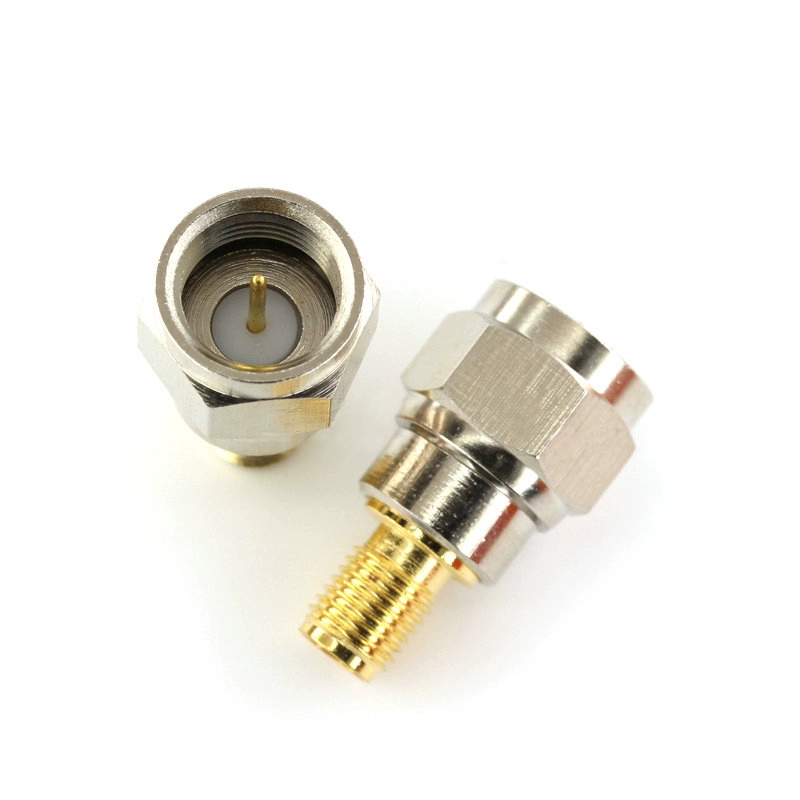
This image illustrates an adapter that connects the world of RF communication (SMA, 50 Ohm) with the world of video transmission (F-Type, 75 Ohm). It visually represents the caution mentioned in the text: while physically possible, connecting 50Ω and 75Ω systems introduces an impedance mismatch, which may be acceptable for short video runs but problematic for precision RF work.
2) SMA Gender & Shorthand Codes You’ll See in Datasheets
For newcomers, datasheets can feel like a puzzle. The drawings look straightforward, yet the shorthand codes often raise eyebrows. Once you understand the JJ / KK / JK / KJ logic, though, the picture clears up fast.
The rule is simple:
- J = pin contact (male)
- K = hole contact (female)
Combine that with thread type, and you can decode nearly any adapter at a glance:
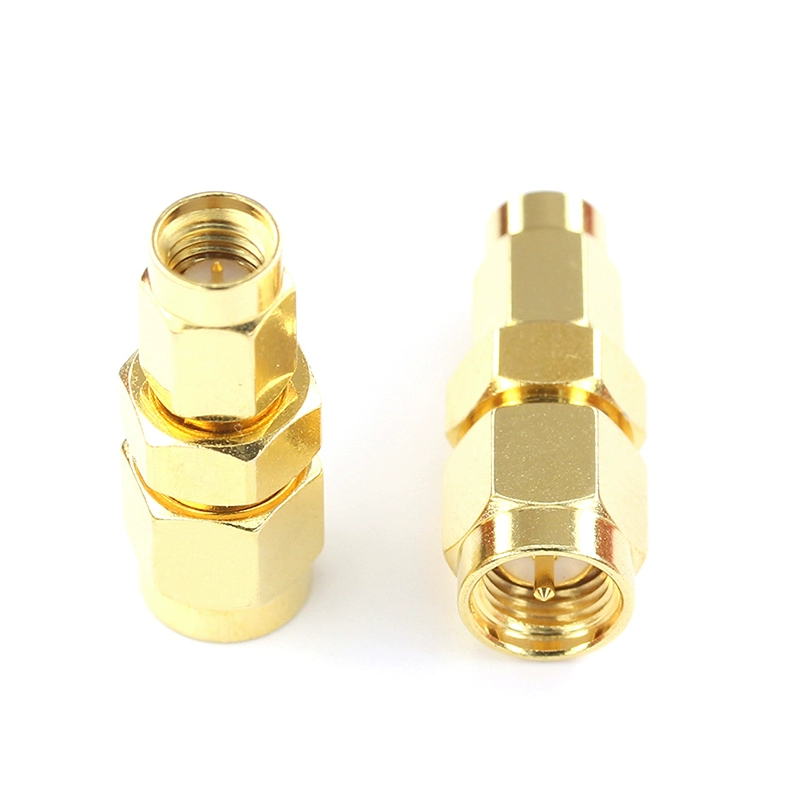
This image provides a clear visual reference for the SMA-JJ adapter type, as defined by the shorthand code where 'J' denotes a male center pin. It shows the physical structure that allows two devices or cables with female SMA jacks (external threads, center socket) to be connected together. This is a fundamental adapter type often used as a simple barrel connector or coupler.
- SMA-JJ: inner-thread, pin ↔ inner-thread, pin (sma male to male adapter)
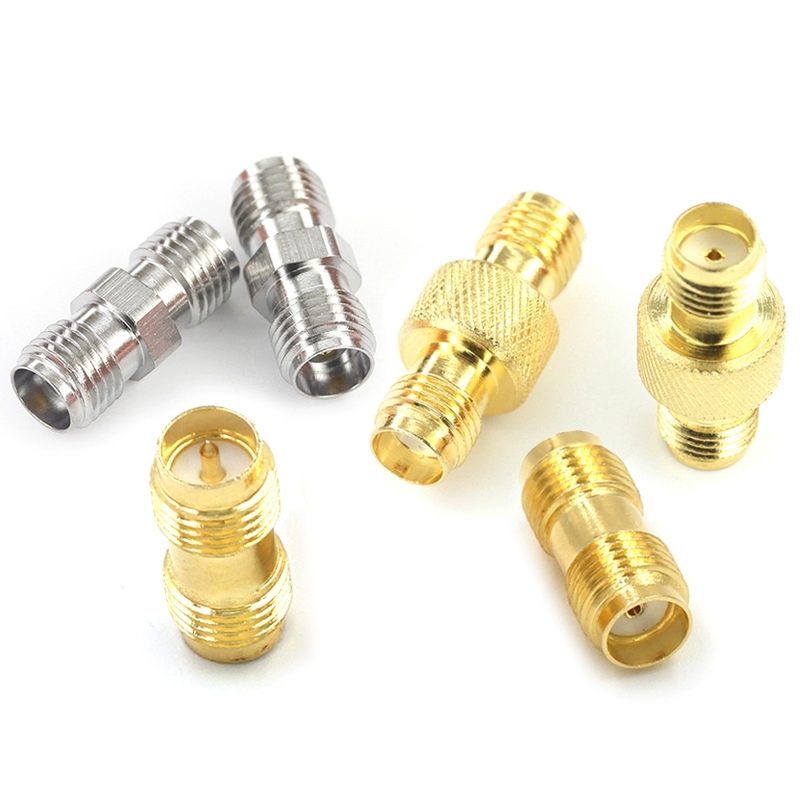
This image depicts the SMA-KK adapter, where 'K' signifies a female center contact (socket). It visually explains how this adapter functions as a coupler for two male SMA connectors (internal threads, center pin), allowing them to be joined. This type is essential for extending cable lengths or connecting two male-ended devices.
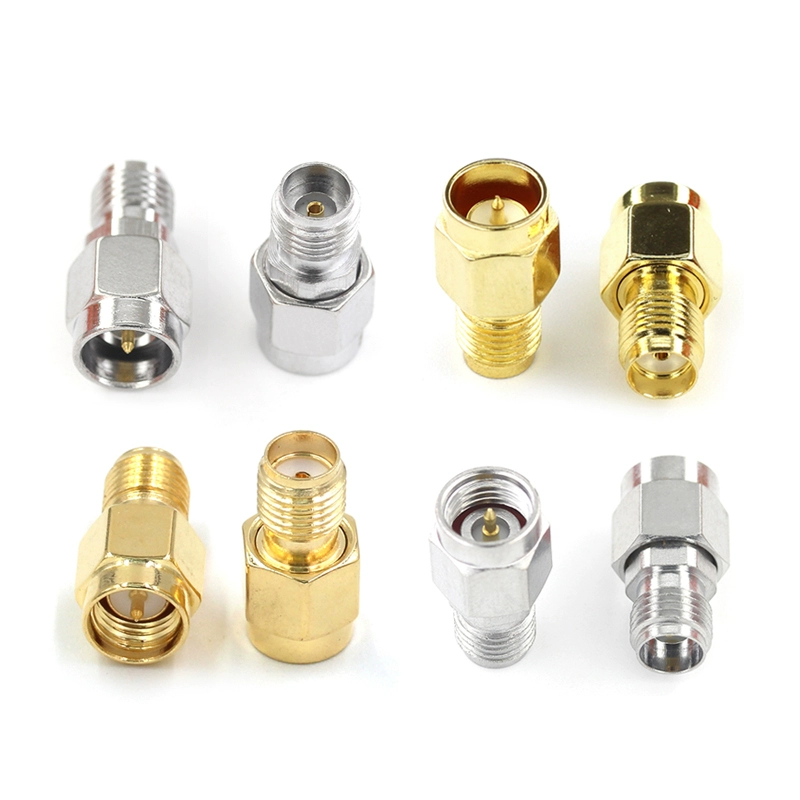
This image shows the most common SMA adapter, the SMA-JK. It demonstrates the connection between a standard male SMA connector (characterized by internal threads and a center pin) and a standard female SMA connector (characterized by external threads and a center socket). This is the go-to adapter for connecting a cable to a device port.
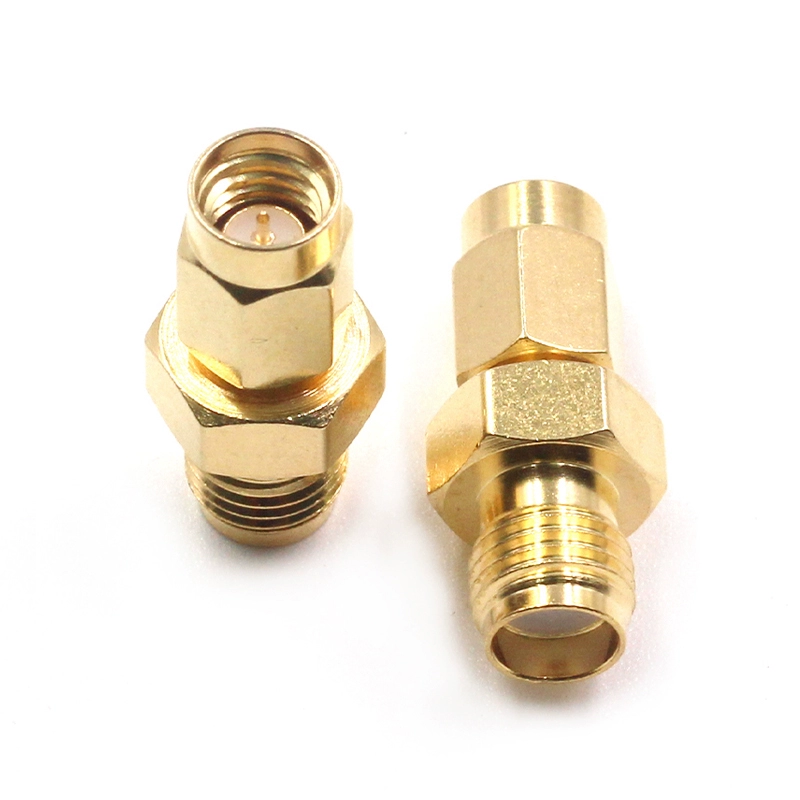
This image clarifies the SMA-KJ adapter type. While less common than SMA-JK, it serves the specific purpose of connecting a device or cable with a female SMA port to another device or cable with a male SMA connector. It completes the set of basic SMA gender changers.
- SMA-KJ: inner-thread, hole ↔ outer-thread, pin (sma female adapter rf)
Here’s a snapshot of TEJTE’s measured specs for these common gender changers:
| Code | Structure | Frequency Range | VSWR | Insertion Loss | Durability | Temp Range |
|---|---|---|---|---|---|---|
| SMA-JJ | Male-Male (inner thread + pin) | DC-12.4 GHz | ≤1.20 @ 0-6 GHz | ≤0.15 dB/6 GHz | 500-1000 cycles | -65 °C ~ +165 °C |
| SMA-KK | Female-Female (outer thread + hole) | DC-12.4 GHz | ≤1.20 @ 0-6 GHz | ≤0.15 dB/6 GHz | 500-1000 cycles | -65 °C ~ +165 °C |
| SMA-JK | Male-Female (outer pin = inner hole) | DC-12.4 GHz | ≤1.20 @ 0-6 GHz | ≤0.15 dB/6 GHz | 500-1000 cycles | -65 °C ~ +165 °C |
| SMA-KJ | Female-Male (inner hole → outer pin) | DC-12.4 GHz | ≤1.20 @ 0-6 GHz | ≤0.15 dB/6 GHz | 500-1000 cycles | -65 °C ~ +165 °C |
Engineers also use extended codes:
- KKY = bulkhead mount with nut and washer.
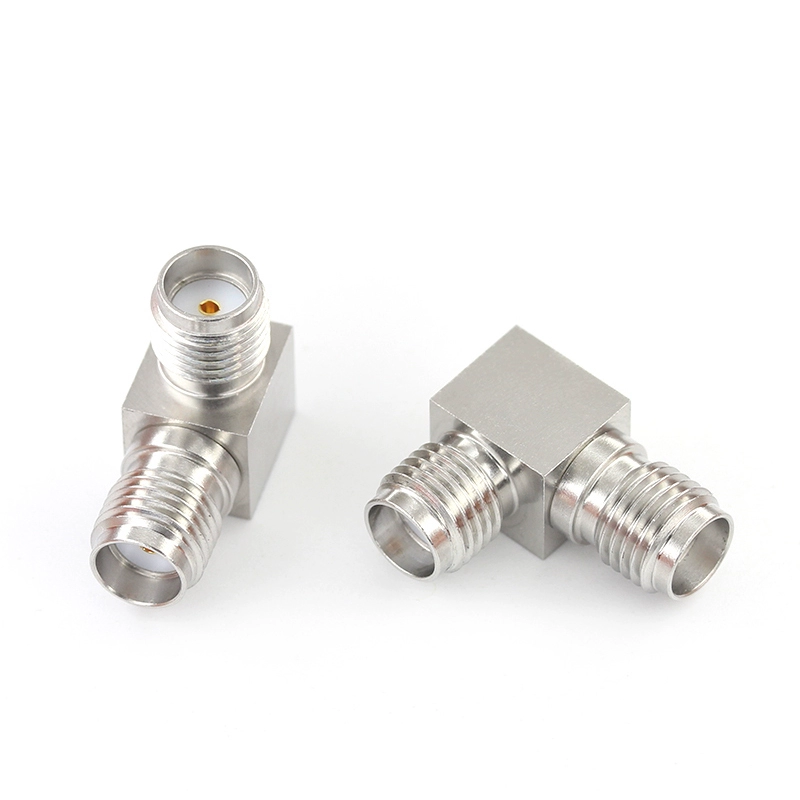
This image illustrates a right-angle form factor SMA adapter, specifically a female-to-female type denoted by the KWK code. It shows how the adapter bends the connection path at a 90-degree angle, which is crucial for routing cables in confined spaces within enclosures or on crowded circuit boards without putting strain on the connectors or cables.
- JWK/KWK = right-angle types, handy in tight spaces.
- SMA to Pin / quick-connect = for test jigs and fast swaps.
In everyday talk, these are simply “sma gender changers.” A JJ lets two female ports mate, KK links two males, and JK/KJ handle the mixed cases. More than one engineer has ordered the wrong part by overlooking this code—learning it once saves both time and budget.
3) Popular Conversion Families
3.1 SMA ↔ BNC
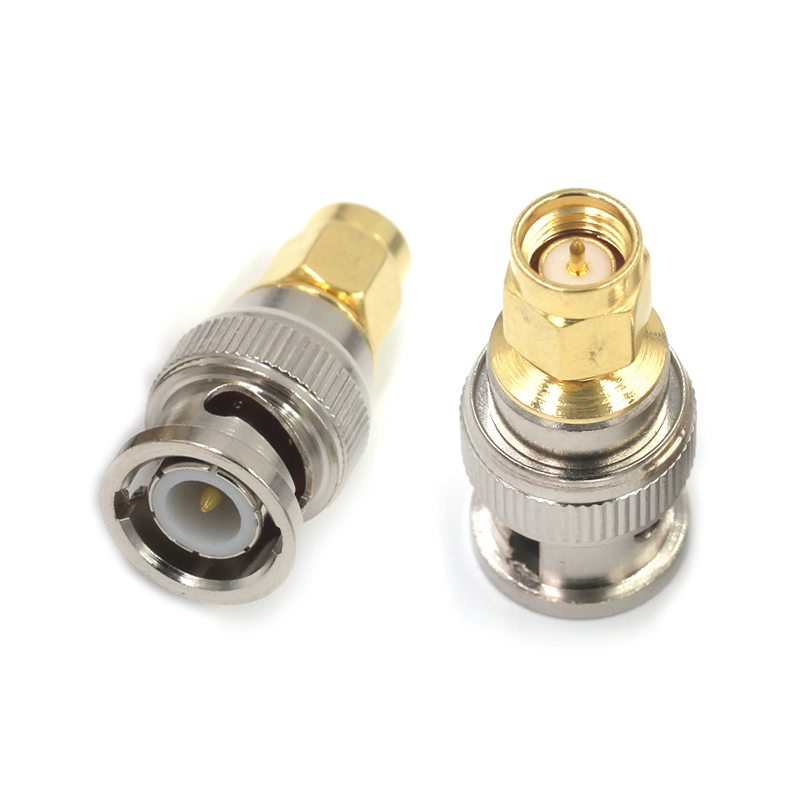
This image depicts one of the most frequently used adapters in laboratories: the SMA to BNC converter. It likely shows a specific combination, such as an SMA male plug adapting to a BNC female jack, which allows modern RF equipment with SMA ports to connect to oscilloscopes, older spectrum analyzers, and other gear using the BNC standard. The visual reinforces the text describing its role as a staple in labs.
The sma to bnc adapter is almost a staple in labs. Oscilloscopes, spectrum analyzers, and function generators still rely heavily on BNC ports, while most RF test leads end in SMA. Rather than re-terminating cables, you just snap in an adapter.
Common variants:
- sma plug to bnc jack adapter
- bnc female to sma male adapter
- bnc male to sma female adapter
- bnc female to sma female adapter
If you’ve worked with video capture cards or monitoring gear, you’ve probably kept a few bnc to sma adapters nearby. Without them, testing setups can turn into a headache of mismatched cables.
3.2 SMA ↔ N-Type
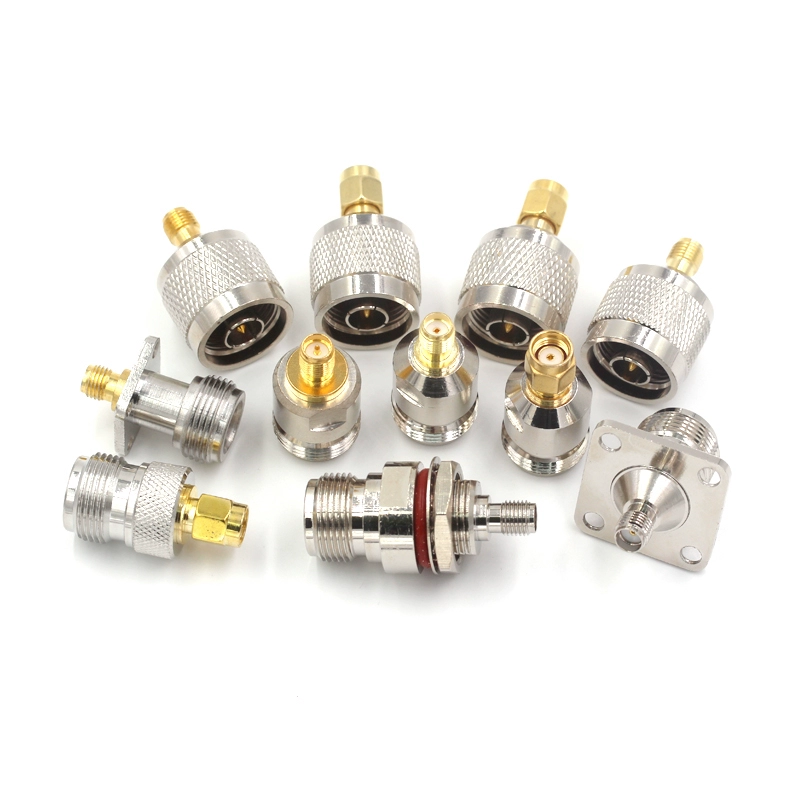
This image shows an adapter bridging the gap between the compact SMA connector and the robust N-Type connector. It visually supports the text explaining its prevalence in outdoor applications like telecom cabinets and access points, where the N-Type's weatherproofing is needed, but the device port might be SMA. The adapter enables this interface conversion.
Step outdoors—telecom cabinets, access points, or RF enclosures—and you’ll see n type to sma adapters everywhere. N connectors are bulky and weatherproof, SMA is compact and precise. The sma male n adapter connects the two worlds.
Typical examples:
- n male to sma female adapter
- sma male to n female adapter
One thing to remember: check impedance. Mixing 50 Ω with 75 Ω may be physically possible but will cause mismatches. In broadcast setups 75 Ω still appears, but in RF data links, stick with 50 Ω.
3.3 SMA ↔ UHF (PL-259 / SO-239)
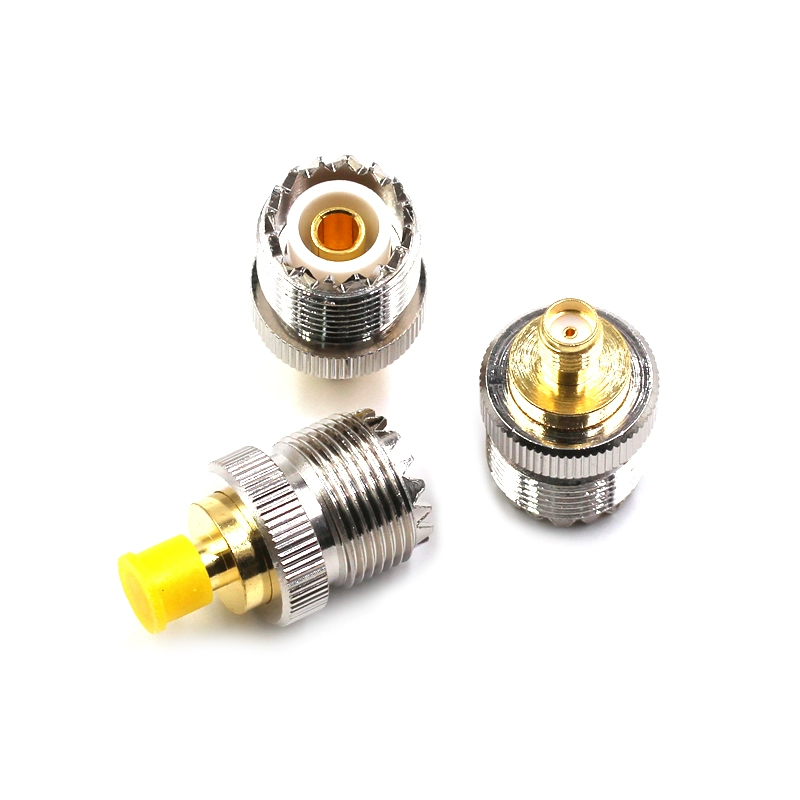
This image depicts an adapter crucial for the amateur radio (ham radio) community. It shows the interface between a common SMA connector found on modern handheld transceivers and the classic UHF connector (SO-239 socket) used on many base station antennas and coaxial feeds. The image underscores the adapter's role as a simple mechanical bridge between different connector generations, as explained in the text.
For amateur radio, the pl259 to sma adapter is a must-have. Handheld radios often come with SMA ports, but antennas are still stuck in the UHF ecosystem.
You’ll find listings like:
- sma female to so239 adapter
- sma male to PL-259 adapter
Some beginners ask: “What are sma-female or SO-239 adapters?” The answer is simple—they’re just mechanical bridges. No magic. Keep in mind, though, that UHF connectors weren’t designed for multi-GHz work. They’re fine for HF and VHF, but at higher frequencies, losses creep in.
3.4 SMA ↔ TNC
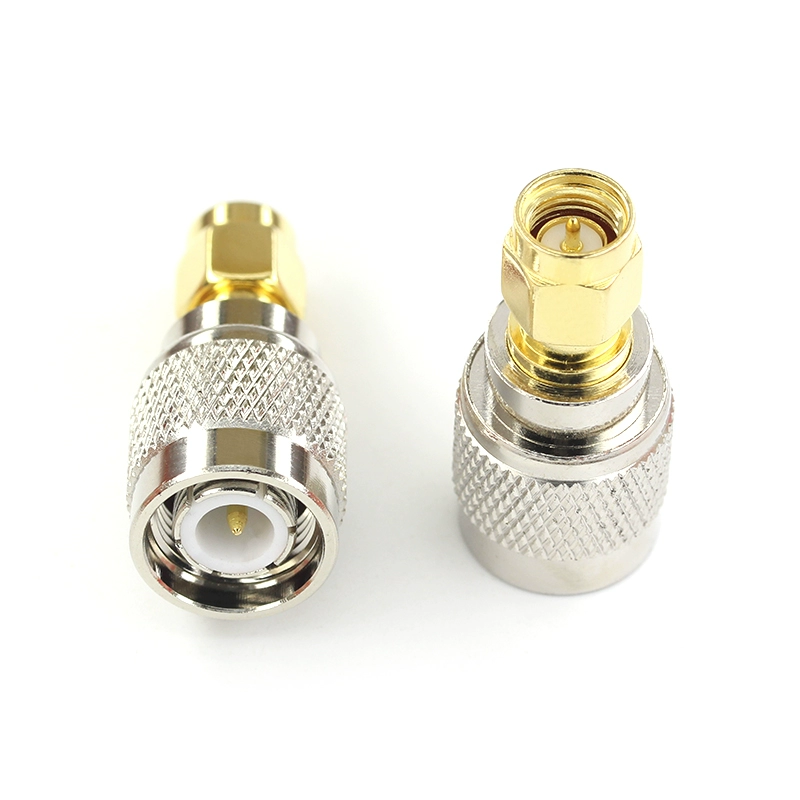
This image shows an adapter connecting SMA and TNC connector families. The TNC connector resembles a threaded version of BNC. The visual aligns with the text describing its application in environments where vibration is a concern (e.g., aerospace, defense) or where a more stable connection than BNC's bayonet style is desired for repeatable test results.
When vibration is the enemy, tnc to sma adapters step up. TNC uses a threaded body like SMA, so it doesn’t loosen under stress.
Variants include:
- sma to tnc adapter
- tnc male to sma female
- tnc female to sma male
You’ll often see them in aerospace or defense gear. In test benches that need repeatable results, the adapter tnc sma avoids the instability that BNC bayonets sometimes suffer.
3.5 SMA ↔ F-Type (75 Ω Video Systems)

This image illustrates an adapter that connects the world of RF communication (SMA, 50 Ohm) with the world of video transmission (F-Type, 75 Ohm). It visually represents the caution mentioned in the text: while physically possible, connecting 50Ω and 75Ω systems introduces an impedance mismatch, which may be acceptable for short video runs but problematic for precision RF work.
The f to sma adapter bridges into consumer electronics—think set-top boxes, satellite receivers, CCTV. These are usually 75 Ω, and that’s where you need to pause.
Examples:
- f female to sma male adapter
- f type female to sma male adapter
- type f female to rp-sma female adapter
Yes, you can connect 50 Ω to 75 Ω with these, and for short video runs it’s usually fine. But for precision RF testing, mismatches are a problem. Use them with awareness.
3.6 SMA ↔ SMB / MCX / MMCX
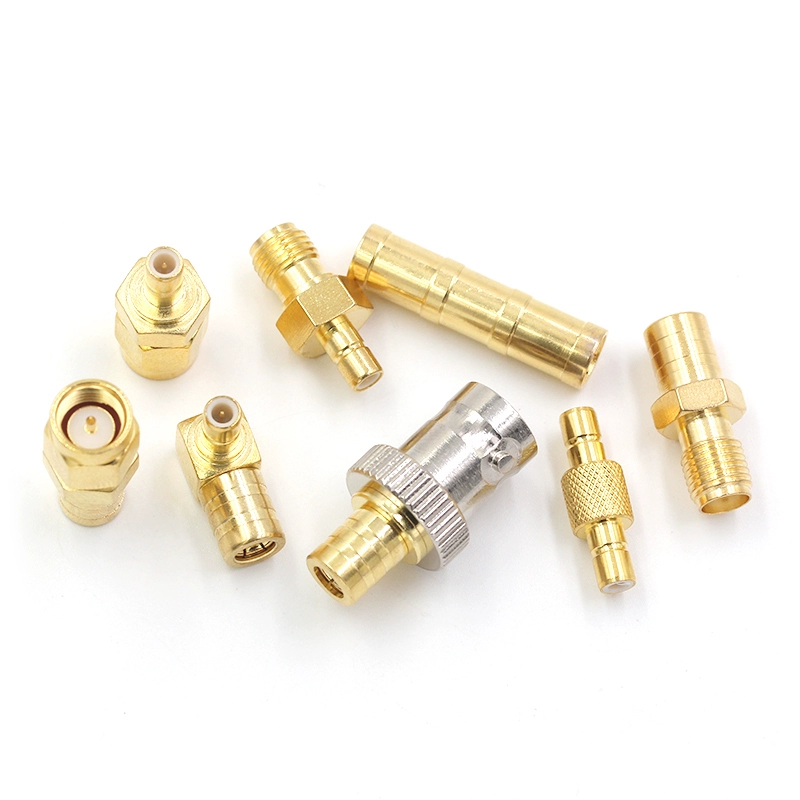
This image shows an adapter that interfaces between the common SMA connector and a miniature coaxial connector such as SMB, MCX, or MMCX. These smaller connectors are frequently used on internal modules, dongles, and consumer electronics where space is limited. The adapter allows test equipment or external antennas with SMA connectors to be connected to these compact devices, as noted in the text for labs and prototyping.
On the mini side, smb to sma adapter and mcx to sma adapter connectors show up in dongles, GPS receivers, or SDR kits. Labs often stock mmcx sma adapters to make swapping antennas quick and painless.
These aren’t designed for high power. Instead, they shine in compact IoT boards, consumer modules, or prototyping environments. If you’ve ever tested a DVB-T stick with an external antenna, chances are you used one of these.
3.7 SMA ↔ RP-SMA (Wi-Fi Ecosystem)
Wi-Fi gear is where confusion really spikes. Many routers use RP-SMA female ports, while aftermarket antennas may come in standard SMA. That’s why rp-sma to sma adapters are so common.
Examples:
- rp sma male to sma female adapter
- rp sma male to rp sma male adapter
The difference? RP (reverse polarity) swaps pin/hole conventions but keeps the same threads. Regulators once pushed this to limit antenna swapping, but today it’s more of an industry habit. Anyone who’s bought the “wrong Wi-Fi antenna connector” has likely solved it with an rp-sma adapter.
3.8 U.FL / IPEX ↔ SMA
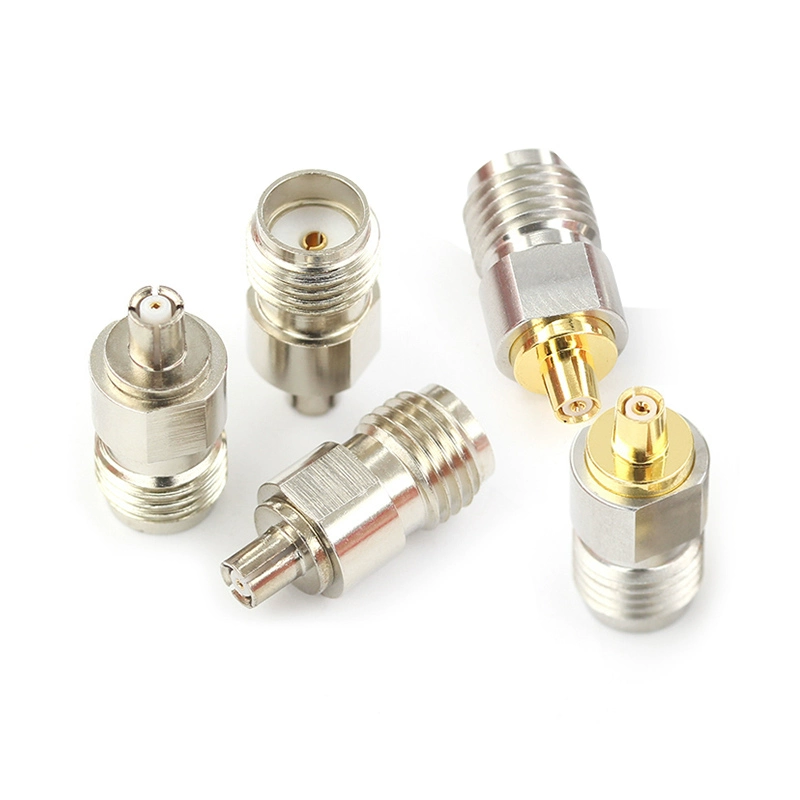
This image depicts a crucial component for wireless device development and testing: the U.FL to SMA pigtail. It shows the extremely miniature U.FL (or IPEX) connector, designed for surface-mounting on PCBs (e.g., inside Wi-Fi cards, LTE modules), connected via a thin coaxial cable (like RG178) to a standard SMA connector. This allows the internal module to be connected to an external antenna or test equipment. The text advises using a pigtail cable instead of a rigid adapter for frequent testing to protect the delicate PCB-mounted U.FL port.
Finally, the tiny world of ufl to sma adapters. These connect PCB-mounted Wi-Fi or LTE modules to external antennas.
Variants:
- u.fl to sma adapter
- u.fl sma adapter cable
A word of advice: U.FL connectors aren’t built for constant reconnects. If you’re testing often, use a pigtail cable instead of a direct adapter head. It saves both the PCB pad and your sanity.
4) Form Factors & Mounting Options
Not every sma adapter looks the same. Once you’ve worked in different environments—tight enclosures, outdoor panels, or crowded racks—you’ll notice how much form factor really matters.
Right-Angle / 90° SMA Adapters
- Sometimes a straight connector simply won’t fit. That’s when a right angle sma adapter or 90 degree sma adapter saves the day. It lets the coax bend without stressing the PCB pad or straining the cable. At lower gigahertz ranges, performance is nearly identical to a straight adapter. Push into 10 GHz territory, and you may start noticing a bit more mismatch.
Bulkhead & Flange-Mount Options
- When you need to pass through a panel, the male to female sma adapter with flange or bulkhead version is the right pick. A threaded body, washer, and nut keep it locked in place. Add an O-ring and you get basic weatherproofing, which is essential for outdoor RF cabinets or antenna boxes.
SMA-to-Pin & Quick-Connect Styles
- In prototyping labs, you’ll often see engineers reaching for the sma to pin adapter. These aren’t for long-term installs but for quick swaps on test jigs. They make it easy to connect and disconnect modules during early development.
Materials & Plating
- Most housings are brass with nickel or gold plating. Stainless steel shows up in harsher environments, especially where durability outweighs cost. The contacts are usually beryllium bronze, gold-plated for low resistance. These aren’t just cosmetic choices—better plating and machining mean your adapter survives hundreds of cycles instead of failing after a dozen.
Once you learn the suffix codes, it’s easier to navigate datasheets: KKY for bulkhead, JWK/KWK for right-angle types, and “flange” for panel mounts. A few minutes of familiarity saves hours of ordering the wrong part.
5) RF Considerations: Impedance, Frequency, VSWR & Loss
Adapters may look like simple metal pieces, but RF performance is never trivial. A mismatched or poorly chosen part can introduce loss, reflections, or instability—issues that only get worse as frequency climbs.
Impedance: 50 Ω vs 75 Ω
- Most sma adapters are built for 50 Ω because that’s the standard for RF and data links. But you’ll also find 75 Ω versions in video and CATV gear. Can you connect them? Physically yes, electrically it causes a mismatch. For short runs it may go unnoticed, but in lab tests or precision work, the ripple effect shows up quickly.
Frequency Range
- A decent adapter covers DC to 12.4 GHz. Premium builds push up to 18 GHz or more. At microwave levels, even a tiny machining flaw can create reflections. If your project involves higher bands, always double-check the datasheet.
VSWR & Insertion Loss
- Good parts maintain VSWR ≤1.20 and insertion loss around 0.15 dB at 6 GHz. That sounds small, but stack a few adapters together and you’ll feel it. Every extra joint adds a little loss, a little mismatch. The simple rule: keep the adapter chain as short as possible.
Right-Angle Effects
- A common question is: “Do sma and rp-sma adapters affect signal?” Yes, but slightly. For a single straight adapter, the effect is tiny. For a right angle sma adapter, performance is still fine up to a few gigahertz. Push into 10+ GHz and the mismatch becomes measurable. If precision matters, stick to straight adapters or use a short pigtail.
Durability vs Performance
- Most datasheets claim 500–1000 mating cycles. In reality, it depends on how carefully you torque them. Over-tightening can damage threads, under-tightening leads to poor ground contact. The recommended torque for SMA is about 0.45 N·m. Ignore that, and you risk unstable results—or worse, a damaged test port.
Bottom line: impedance match first, minimize adapter count, and respect torque limits. It’s the unglamorous side of RF work, but it’s also what separates a clean measurement from a puzzling failure.
6) When You Actually Need a Cable (and When You Don’t)
Not every mismatch calls for a rigid metal adapter. Sometimes the smarter move is grabbing a sma adapter cable, also known as a pigtail. These short jumpers add flexibility where a solid coupler would put stress on delicate parts.
When to use a cable:
- If you’re linking a fragile board-mounted port such as U.FL or MMCX, a u.fl to sma cable takes the stress away from the PCB.
- Inside compact housings, a short jumper lets you position the SMA jack on the enclosure wall without bending the coax at harsh angles.
- For connections that get mated and unmated daily, cables protect the expensive ports while absorbing wear and tear themselves.
When an adapter is enough:
- In static rack setups where nothing moves once it’s connected.
- During quick lab measurements when you want the lowest possible insertion loss.
- For short-term or low-frequency use where strain isn’t an issue.
A word of caution: people often search for “sma to ethernet adapter” or “sma to rj45 adapter.” These don’t exist in the passive sense. Ethernet and SMA are two different worlds—one digital protocol, one analog RF interface. To connect them, you need active hardware like a modem, RF bridge, or MoCA converter. Any listing suggesting otherwise is either mislabeled or describing a specialized piece of equipment.
So here’s the quick rule set:
- Adapters solve geometry problems.
- Cables solve stress and layout problems.
- Active devices solve protocol conversions.
Remember that, and you’ll save yourself both frustration and wasted parts.
7) Buying Checklist & Quick Matrix
Shopping for sma adapters can feel overwhelming. Between endless part numbers, gender codes, and suffixes, it’s easy to click the wrong one. A simple checklist keeps you on track.
Step-by-step buying checklist:
- Identify the interfaces. Is it SMA-to-SMA, or SMA-to-BNC, N, TNC, UHF, F, or something else?
- Confirm direction. Do you need male-to-male (JJ), female-to-female (KK), or a mixed pair (JK/KJ)?
- Check impedance. Stick with 50 Ω for RF/data. If you’re in CATV or video systems, 75 Ω might be correct.
- Verify frequency range. Standard adapters cover DC–6 GHz; better builds go up to 12 or 18 GHz.
- Choose form factor. Straight, right-angle, flange, or bulkhead—whatever suits your layout.
- Look at materials. Brass is common. Stainless steel versions cost more but survive harsher use.
- Decide on quantity. Do you just need one, or would a full kit be more cost-effective?
Quick Conversion Matrix (JJ/KK/JK/KJ across connector families):
| SMA Type | BNC | N-Type | TNC | UHF (PL-259 / SO-239) | F-Type | SMB / MCX / MMCX |
|---|---|---|---|---|---|---|
| JJ (Male-Male) | SMA-JJ → BNC Male | SMA-JJ → N Female | SMA-JJ → TNC Male | SMA-JJ → SO-239 | SMA-JJ → F Female | SMA-JJ → MCX / MMCX Female |
| KK (Female-Female) | SMA-KK → BNC Male | SMA-KK → N Male | SMA-KK → TNC Male | SMA-KK → PL-259 | SMA-KK → F Male | SMA-KK → MCX / MMCX Male |
| JK (Male-Female) | SMA-JK → BNC Male | SMA-JK → N Male | SMA-JK → TNC Male | SMA-JK → SO-239 | SMA-JK → F Male | SMA-JK → MCX / MMCX Male |
| KJ (Female-Male) | SMA-KJ → BNC Female | SMA-KJ → N Female | SMA-KJ → TNC Female | SMA-KJ → PL-259 | SMA-KJ → F Female | SMA-KJ → MCX / MMCX Female |
For many engineers, the easiest option is buying sma connector adapter sets. These kits bundle the most-used couplers—JJ, KK, JK, KJ—plus essentials like SMA-to-BNC and SMA-to-N converters. Having a set on hand means fewer interruptions and fewer “oops, wrong adapter” moments.
One last tip: resist the temptation to go for the cheapest part. Poor machining or low-quality plating can increase insertion loss or even damage expensive ports. If you’ve ever stripped the SMA threads on a $20,000 spectrum analyzer, you’ll know why spending a bit more upfront is the smarter choice.
8) FAQs
Do sma and rp-sma adapters affect signal?
Yes, but usually only a little. A good adapter adds about 0.1–0.2 dB of loss up to a few gigahertz. That’s small enough that most Wi-Fi users won’t notice. Stack three or four together, though, and the loss becomes obvious. Rule of thumb: keep the chain short.
What are sma-female or SO-239 adapters?
This comes up often in ham radio forums. An sma female to SO-239 adapter lets a handheld with an SMA port connect to an older UHF antenna using a PL-259. It doesn’t change the antenna’s frequency band—it only changes the connector shape. Nothing more, nothing less.
What is an sma adapter / sma male adapter?
An sma adapter is simply a mechanical coupler. A sma male adapter just means the adapter has a male SMA side (center pin). It might be paired with another SMA, or with a completely different connector family. Don’t overthink it—it’s about physical fit, not protocol translation.
Can I use a right-angle SMA without noticeable loss?
Most of the time, yes. At 2.4 GHz Wi-Fi or even 5 GHz IoT systems, the difference is negligible. Push into 10 GHz or higher, and you may see a mismatch creep in. If you’re chasing precision measurements, use straight adapters. If you’re hooking up a router, a right angle sma adapter is perfectly fine.
Are “sma to Ethernet / RJ45” adapters real?
No. SMA carries analog RF. Ethernet and RJ45 are digital. To bridge the two, you need active electronics like a modem, RF-to-Ethernet bridge, or MoCA adapter. If you see a “sma to rj45 adapter” online, it’s either mislabeled or meant for a very specific piece of hardware.
Which adapter for Baofeng radios?
Baofeng radios often ship with SMA female ports, but not always—some models use SMA male. That’s why people search for a baofeng sma adapter so often. The common solutions are sma female to SO-239 or sma female to PL-259. Always check your specific radio before ordering; Baofeng has used both versions across models.
Conclusion
The world of sma adapters can feel messy at first, but once you learn the basics—gender codes (JJ, KK, JK, KJ), impedance, and the popular conversion families—it becomes much easier to navigate.
Here are the essentials worth remembering:
- Keep adapter chains short to minimize loss.
- Match impedance: 50 Ω for RF, 75 Ω for video.
- Pick the right form factor: straight for clean layouts, right-angle for tight spaces, bulkhead/flange for panels.
- Don’t skimp on quality. A $5 adapter can protect a $20,000 test port.
For labs, IoT projects, or amateur stations, a small kit of sma connector adapter sets covers most needs. For the oddball cases, specialty adapters—like U.FL to SMA or RP-SMA to SMA—fill the gaps.
And if you’re planning more than just one or two adapters, think ahead. Bulk orders or custom assemblies from a trusted supplier like TEJTE ensure consistency, proper specs, and fewer headaches down the road.
Bonfon Office Building, Longgang District, Shenzhen City, Guangdong Province, China

A China-based OEM/ODM RF communications supplier
Table of Contents
Owning your OEM/ODM/Private Label for Electronic Devices andComponents is now easier than ever.
